
TOPIC SENTENCE/ In his numerous writings, Marx critiques capitalism by identifying its flaws. ANALYSIS OF EVIDENCE/ By critiquing the political economy and capitalism, Marx implores his reader to think critically about their position in society and restores awareness in the proletariat class. EVIDENCE/ To Marx, capitalism is a system characterized by the “exploitation of the many by the few,” in which workers accept the exploitation of their labor and receive only harm of “alienation,” rather than true benefits ( MER 487). He writes that “labour produces for the rich wonderful things – but for the worker it produces privation. It produces palaces—but for the worker, hovels. It produces beauty—but for the worker, deformity” (MER 73). Marx argues capitalism is a system in which the laborer is repeatedly harmed and estranged from himself, his labor, and other people, while the owner of his labor – the capitalist – receives the benefits ( MER 74). And while industry progresses, the worker “sinks deeper and deeper below the conditions of existence of his own class” ( MER 483). ANALYSIS OF EVIDENCE/ But while Marx critiques the political economy, he does not explicitly say “capitalism is wrong.” Rather, his close examination of the system makes its flaws obvious. Only once the working class realizes the flaws of the system, Marx believes, will they - must they - rise up against their bourgeois masters and achieve the necessary and inevitable communist revolution.
Not every paragraph will be structured exactly like this one, of course. But as you draft your own paragraphs, look for all three of these elements: topic sentence, evidence, and analysis.
- picture_as_pdf Anatomy Of a Body Paragraph
Informative Essay


What is an Informative Essay and How to Write One?
11 min read
Published on: Aug 11, 2021
Last updated on: Oct 26, 2024

People also read
Good Informative Essay Topics for All Academic Levels
Share this article
Have you been assigned an informative essay but don’t know where to start? This guide has got you covered!
An informative essay is a common assignment for school or college students. The goal is to provide detailed information to the readers about the specific topic.
Read on to find simple step-by-step instructions for writing an interesting and engaging informative essay. You’ll also get to read helpful examples and tips you can follow to make your essay even better!
Let’s dive in!
On This Page On This Page -->
Informative Essay Definition
The informative essay can be simply defined as,
"A form of essay writing that aims to educate and inform the reader about a specific topic."
Informative essays can cover a variety of topics. It could be written about a particular thing, event, or natural phenomenon, etc.
This type of essay highlights the objective facts and evidence without reflecting the writer's subjective point-of-view about the topic.
What is the Purpose of an Informative Essay?
An informative essay presents objective and verifiable information about a topic. It relies on factual evidence and reliable sources.
The main goal of writing an informative essay is to;
- Inform the reader about something.
- Explain a particular subject.
- Transmit verified knowledge clearly and concisely.
Types of Informative Essay
There are several types of informative essays, and each type has its own purpose and style. Here are some of the informative essay types that you need to know.
- Descriptive Essay
A descriptive essay is an essay that describes something about an event, person, place, or idea in detail. The descriptive essay aims to provide enough information to the readers to visualize or imagine the matter described.
Want to know more about descriptive essays? Check out this descriptive essay writing blog to learn more.
- Cause and Effect Essay
The cause and effect essay describes the cause of an event or idea and then explains its effects on today’s world and people. Also, this type of essay is a common form of organization in academic writing.
However, the cause-and-effect essay requires strong research skills. Without them, your essay will not become a successful piece of writing.
- Compare and Contrast Essay
In a compare and contrast essay, the writer discusses the similarities and differences between two or more things. This type of essay also requires strong critical thinking skills.
Therefore, when you start writing the compare and contrast essay , you should identify and analyze the subject from all angles and characteristics.
- Process Essay
The process essay is also known as the "How-To" essay. This essay provides information about how a process occurs or about the process of doing something.
- Problem-Solution Essay
A problem-solution essay is another common type of informative essay in which you describe a problem and then propose its solution. Its main purpose is to educate the readers on the problem and its significance.
Looking for more information? Visit our problem-solution essay guide and learn to write perfect problem solution essays.
- Expository Essay
The expository essay explains, illustrates, or interprets something in a way that becomes easy for the readers. This essay provides a fair analysis of the subject based on facts without the writer’s opinions.
Here is a simple video that explains informative writing:
How to Start an Informative Essay?
Before you can start writing, you have to do some "rewriting." Here are the steps involved in prewriting:
- Brainstorm Ideas
Brainstorming is the first step in writing any type of essay . Here, you brainstorm several topic ideas and generate a list of potential topics.
So think about all the possible ideas that are related to your interest and subject. This will help you choose an interesting topic for your essay.
- Choose a Topic
Choosing the right topic is essential for writing a great essay. A good topic will not only make your writing process easy but also make the research phase interesting.
So choose a topic you can easily write about and support it with facts, evidence, and statistics. In short, the topic should be interesting and easy to research.
- Know Your Target Audience
Your audience determines the style and tone of your essay. Consider who will be reading your essay and what their background, knowledge, and interests might be.
For instance, if you are writing for school children, your language should be simple, easy, and interesting. Meanwhile, writing for a professional audience requires you to use technical terminology and jargon.
So always think about who you are writing for and determine your audience before proceeding.
- Do the Research
You have to do some research to gather information for your essay. Make sure the information that you collect is reliable and accurate.
Use a variety of sources for research, including research articles, books, documentaries, etc. You should also take detailed and organized notes to keep track of the information you find, so you can use it later.
- Create an Outline
An essay outline helps the writer keep their focus strong and narrow. With the help of an outline, you will easily organize your thoughts and ideas.
So create an outline of your essay to lay out a structure.
Don't know how to make an informative essay outline? Don’t worry, read on to find out.

Paper due? Why Suffer? That's our job.
Informative Essay Outline
Crafting a well-structured essay involves planning what points to include and how it all ties together. Creating an outline is the best way to ensure that your work is well-structured.
An informative essay outline is outlined in the following way:
Let’s discuss these outline parts in detail.
Introduction
- Start with a captivating hook that grabs the reader's attention. It could be an intriguing fact, a relevant quote, or a thought-provoking question.
- State your thesis statement . It is the last part of the introduction that clearly presents the main idea or argument of your essay. It should reflect the informative nature of your essay and guide the reader on what to expect.
- Divide the body of your essay into several paragraphs. Each paragraph should focus on one specific aspect or subtopic related to your main thesis.
- Start each paragraph with a topic sentence that introduces the main point of that paragraph.
- Analyze and discuss your supporting evidence. They could be examples, facts, or statistics that provide informative content.
Conclusion
- Summarize the main points covered in your essay.
- End with a thought-provoking statement, a call to action, or a suggestion for further exploration of the topic.
Here is an example outline template that you can use to write your informative essay outline
Informative Essay Outline Template
How to Write an Informative Essay?
Once you have done the prewriting, you have got everything you need to start. Following the steps below will help you write a great informative essay.
How to Write an Informative Essay Introduction?
The introduction of an essay sets the tone of the essay and provides an overview of the topic. Here are some key elements you need to include when writing an informative essay introduction:
- Attention-Grabber / Hook:
The hook is the first line of the essay that aims to pique the readers’ interest. This can be:
- An interesting fact,
- A thought-provoking question,
- Or a compelling anecdote related to your topic, etc.
The hook should be related to your topic and should be engaging enough to grab the reader's attention.
Struggling to come up with a good hook? These 200+ hook examples will help you craft an excellent hook!
- Background Information:
After grabbing the reader’s attention, you have to them to your topic. Discuss some background details on the topic to provide context.
Also, discuss the relevance or importance of the subject matter. This helps the reader understand the significance of the information you're about to present. Moreover, use clear and concise language to provide essential and interesting details to make the reader want to continue reading.
- Thesis Statement:
The thesis statement presents the main topic or idea of the essay in a concise and clear way. It provides an overview of what will be covered.
The thesis statement is the last part of the introduction. It should be specific, focused, and encompass the main ideas you'll be discussing in the body of the essay.
How to Write an Informative Essay Body Paragraphs?
The body paragraphs are the major chunk of your essay. They provide all the information about your chosen topic. There should be at least three body paragraphs in your essay, although there can be more depending on your topic.
Here are the key elements of the informative essay body paragraphs:
- Topic Sentence
Begin each body paragraph with a clear topic sentence that introduces the main point you will be discussing in that paragraph. It is the first sentence of the paragraph and should be clearly related to the thesis.
- Provide Information and Evidence
In an informative essay, information and evidence should be presented clearly and logically. So present the facts, examples, statistics, or quotations that inform the reader about the topic. This information should come from reliable and credible sources.
- Discuss and Elaborate
After presenting the evidence, explain and discuss them to ensure a thorough understanding of the information. Clarify any complex terms, concepts, or ideas that may require explanation for understanding the topic effectively.
- Use Transitional Phrases:
Use transitional phrases or sentences to connect paragraphs and ideas. This helps maintain a cohesive flow of information throughout the essay.
For instance, transitional words such as "moreover," "furthermore," "on the other hand," or "in addition to" can be used to link ideas logically.
Having a difficult time with smooth transitions? Here’s a list of transition words for essays to help you out!
How to Write an Informative Essay Conclusion?
In an essay conclusion , you wrap up the essay and provide a sense of closure. Writing the informative essay conclusion includes the following steps:
- Summarize the Main Points:
Revisit the main points covered in your essay's body paragraphs and provide a concise summary of the information presented. Do not introduce any new information or arguments in the conclusion.
- Restate your Thesis Statement
Begin your conclusion by restating your thesis statement in a slightly different way. This helps remind the reader of the main objective of your essay.
- Provide a Thought-Provoking Statement:
End your conclusion with a thought-provoking statement, reflection, or question that leaves a strong impression on the reader. This can help inspire them to continue exploring the topic beyond your essay.
Edit and Proofread the Essay
Once you are done with your first draft, take some time to proofread and revise you essay. Check for grammar and spelling, format, logical coherence, and clarity. Remove any repetitive statements or unnecessary details.
Revising your essay will make it even better and more interesting to read.
Informative Essay Examples
Reading some good examples will make writing an informative essay easier for you. Here are a few short informative essay examples that demonstrate how it looks like. Be sure to read them out.
Informative Essay about Stress
Informative Essay on Diabetes
Informative Essay on Netflix
Informative Essay on Tree in Winter
Informative Essay Topics
A good essay topic is a key to a successful essay. Here are a few ideas that will get you inspired:
- The Benefits of Regular Exercise
- The Importance of Recycling
- The Process of Photosynthesis
- What was the Big Bang?
- The History of the Internet
- How did the Dinosaurs go extinct?
- The Benefits of Meditation
- The Impact of Climate Change on Ecosystems
- The Role of Technology in Education
Stuck on choosing your topic? Don’t worry! Check out our list 200 informative essay topics to get inspiration!
To Sum Up,
This guide introduced everything you needed to start writing an informative essay. By following the steps outlined in this guide, you can confidently embark on your informative writing journey.
Are you in a race against the deadline and need professional help? We’ve got you covered!
We are a legit essay writing service with professional essay writers. Our team of experts writes high-quality, original, and customized essays tailored to your unique requirements.
Our essay writing service has worked on informative essays and academic papers on various topics, with a high rate of customer satisfaction!
You can also maximize the benefits of our AI writing tool to polish and refine your writing skills.
Frequently Asked Questions
What should be included in an informative essay.
Here are some points that should be included in an informative essay.
- Thesis statement
- Strong evidence
- Examples
What is the main topic of an informative essay?
The main topic of an informative essay is to educate the readers on a specific topic.
Nova A. (Literature, Marketing)
As a Digital Content Strategist, Nova Allison has eight years of experience in writing both technical and scientific content. With a focus on developing online content plans that engage audiences, Nova strives to write pieces that are not only informative but captivating as well.
Need Help With Your Essay?
Also get FREE title page, Turnitin report, unlimited revisions, and more!
Keep reading

OFF ON CUSTOM ESSAYS
Essay Services
- Argumentative Essay Service
- Descriptive Essay Service
- Persuasive Essay Service
- Narrative Essay Service
- Analytical Essay Service
- Expository Essay Service
- Comparison Essay Service
Writing Help
- Term Paper Writing Help
- Research Writing Help
- Thesis Help
- Dissertation Help
- Report Writing Help
- Speech Writing Help
- Assignment Help
Legal & Policies
- Privacy Policy
- Cookies Policy
- Terms of Use
- Refunds & Cancellations
- Our Writers
- Success Stories
- Our Guarantees
- Affiliate Program
- Referral Program
Disclaimer: All client orders are completed by our team of highly qualified human writers. The essays and papers provided by us are not to be used for submission but rather as learning models only.

Informative Essay
Informative essay generator.
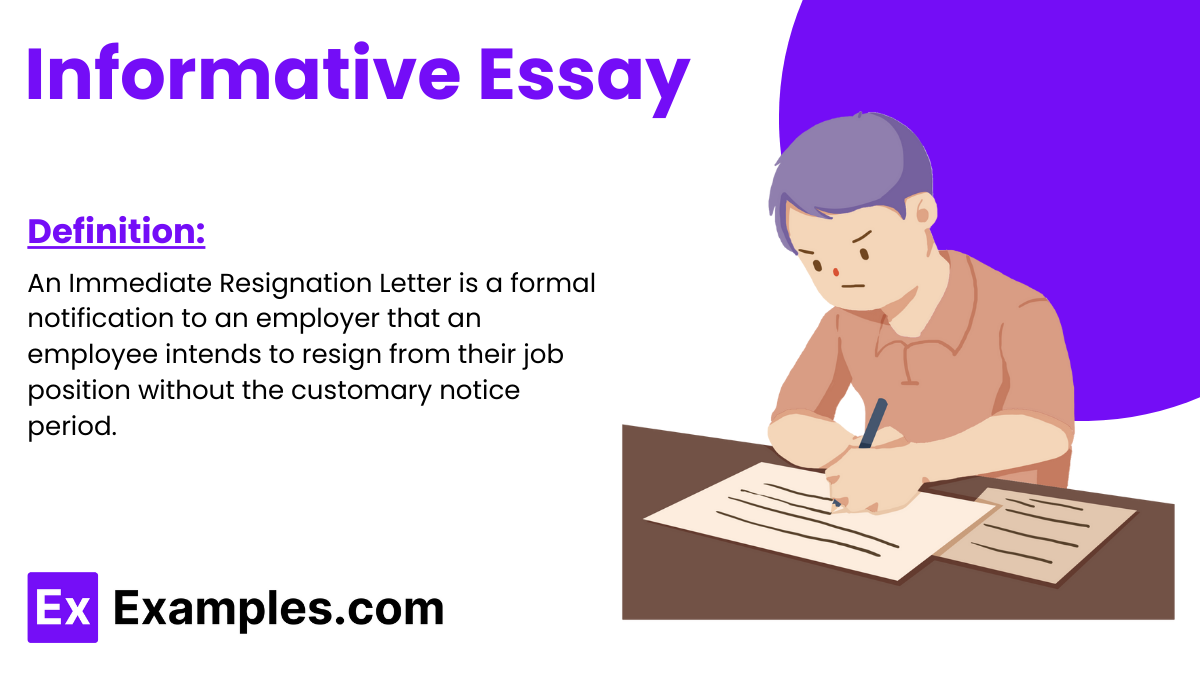
An Informative Essay stands out in the academic world as a tool for students to elaborate on specific topics with depth and clarity. By incorporating factual details and supporting evidence, these essays educate and enlighten the reader. This guide, enriched with practical essay examples , is tailored to assist students in mastering the art of crafting compelling and informative essays. Whether for school assignments or personal exploration, these examples provide valuable insights into effective informative essay writing.
What is an Informative Essay?
An informative essay is a genre of writing aimed at educating the audience on a particular topic or subject. This type of essay doesn’t just offer facts but also provides insights and explanations to help readers understand the subject matter more deeply. Unlike persuasive essays, which aim to convince readers of a particular viewpoint, informative essays are neutral; they do not express the writer’s personal opinions or arguments.
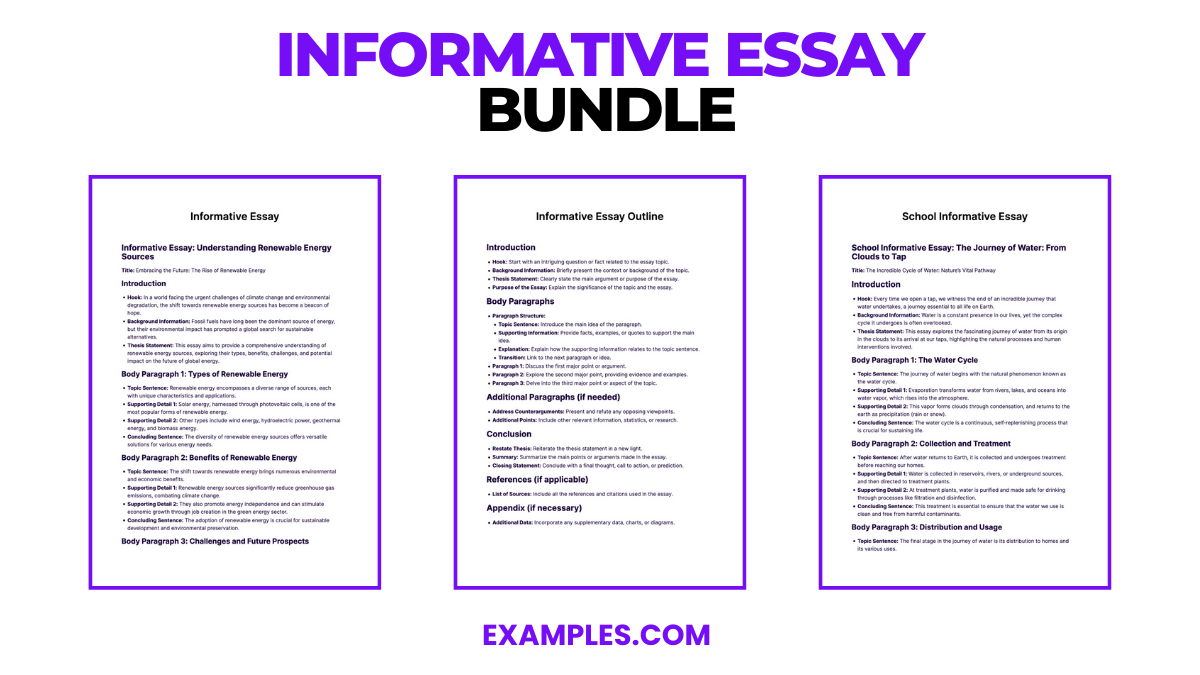
Download Informative Essay Bundle
You may have already been flooded with all these load of essays that your teacher asked you to write. You are probably thinking of a clever way on how to get away from the situation where you probably have not ever dreamed of. However, it is a task that we should all be thankful for. Essay writing actually brings more benefits than browsing through those social media platforms that you have already memorized. It does not only sharpen your minds and makes you more creative than putting likes and hitting shares of your friends’ post. The ability to share something from your mind is definitely a plausible act.
Informative Essay Format
Crafting an informative essay requires a structured approach to organize the wealth of information in a way that’s easily understandable to the reader. The format of an informative essay typically consists of three main parts: the introduction, the body, and the conclusion. Following this format helps in developing a coherent and logically flowing essay that effectively informs the reader.
Introduction
The introduction sets the stage for the entire essay. It should start with a hook that grabs the reader’s attention, such as a surprising fact, a question, or a vivid description of the topic. Following the hook, provide some background information to help readers understand the context of the essay. Finally, the introduction should end with a clear and concise thesis statement that outlines the main points or aspects of the topic that will be discussed. This statement acts as a roadmap for the essay, guiding the reader through the information presented.
Components of the Introduction: Hook : Engages the reader’s interest. Background Information : Provides context for the topic. Thesis Statement : Outlines the main points to be discussed.
Body Paragraphs
The body of an informative essay is where the main information is presented. It should be divided into paragraphs, with each paragraph focusing on a specific point or aspect of the topic. Start each paragraph with a topic sentence that introduces the point to be discussed. Follow this with supporting details, such as facts, examples, statistics, and quotes from credible sources. Each paragraph should be coherent and focused, contributing to the overall argument or presentation of the topic.
Structure of Body Paragraphs: Topic Sentence : Introduces the main idea of the paragraph. Supporting Details : Facts, examples, and evidence supporting the topic sentence. Transition : Smoothly connects to the next paragraph or point.
The conclusion of an informative essay wraps up the essay by summarizing the main points discussed. It should restate the thesis statement in a new way, reflecting the information presented in the essay. The conclusion can also highlight the importance or relevance of the topic, offering final insights or thoughts for the reader to consider. This section should leave the reader with a clear understanding of the topic and its significance. Elements of the Conclusion: Restatement of Thesis : Reflects the main points made in the essay. Summary of Main Points : Briefly recaps the key information discussed. Final Insight : Offers closing thoughts or implications of the topic.
Formatting Tips:
Use clear and concise language throughout the essay. Ensure each paragraph flows logically to the next. Cite sources where necessary to back up facts and claims. Keep the essay focused on informing the reader, avoiding personal opinions.
Types of Informative Essay
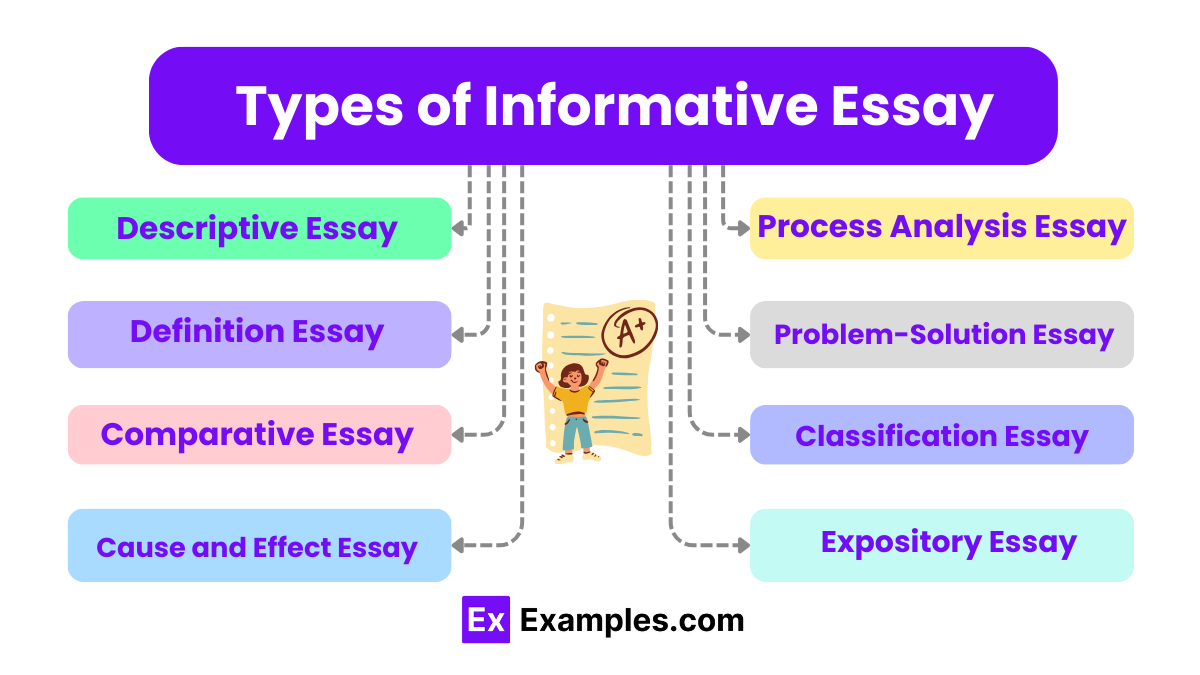
Download This Image
- Descriptive Essay : Provides a detailed description of a person, place, object, or event, using sensory details to paint a vivid picture for the reader.
- Definition Essay : Explores the meaning, history, and implications of a complex concept or term, offering a deep and thorough understanding beyond basic definitions.
- Compare and Contrast Essay : Analyzes two or more subjects by comparing their similarities and contrasting their differences, highlighting the nuances between them.
- Cause and Effect Essay : Examines the reasons why something happened (cause) and the outcomes that followed (effect), aiming to establish a clear relationship between events.
- Process Analysis Essay : Explains how something is done, how something occurs, or how something works, in a step-by-step format, providing clear instructions or insights.
- Problem-Solution Essay : Identifies a specific problem and proposes one or more solutions, focusing on presenting viable and effective ways to address the issue at hand.
- Classification Essay : Organizes or sorts different subjects or objects into categories based on shared characteristics, providing a clear understanding of their relationships and differences.
- Expository Essay : Presents a balanced analysis of a topic, using facts, statistics, and examples, aiming to explain or clarify a subject in a straightforward, unbiased manner.
How is an Informative Essay Structured?
An informative essay is structured in a clear, organized manner to effectively convey information to the reader. This structure consists of three main parts: the introduction, the body paragraphs, and the conclusion. Here’s how each part is typically organized:
- Hook : Begins with a captivating opening to grab the reader’s attention. This could be an interesting fact, a question, or a startling statistic related to the topic.
- Background Information : Provides context for the topic being discussed. This section gives the reader any necessary background information to understand the essay.
- Thesis Statement : Concludes the introduction with a clear, concise statement that outlines the main points or focus of the essay. This statement guides the rest of the essay.
- Topic Sentence : Each body paragraph starts with a topic sentence that introduces the main idea of the paragraph, relating back to the thesis statement.
- Supporting Details : These are facts, examples, or explanations that provide evidence to support the topic sentence. This may include statistics, quotes from credible sources, or logical arguments.
- Analysis : This section interprets the supporting details, explaining how they relate to the topic and the thesis statement. It’s where the writer’s insight comes into play, providing depth to the information presented.
- Transition : Each paragraph ends with a sentence that provides a smooth transition to the next paragraph, maintaining the flow of the essay.
- Summary of Main Points : Begins by briefly summarizing the key points or information presented in the body paragraphs, reinforcing the essay’s main ideas.
- Restatement of the Thesis : Reiterates the thesis statement in light of the information and analysis provided, emphasizing the essay’s main argument or focus.
- Closing Statement : Concludes with a final thought or call to action, leaving the reader with something to ponder or suggesting steps for further exploration of the topic
7 steps for Writing an Informative Essay
- Choose Your Topic : Select a topic that interests you and meets the assignment’s criteria. Ensure it is broad enough to research but narrow enough to be covered in your essay.
- Conduct Research : Gather information from reliable sources to understand your topic thoroughly. Look for facts, statistics, and examples that will provide a solid foundation for your essay.
- Create an Outline : Organize your thoughts and research into an outline. This will help structure your essay logically, ensuring a clear flow of ideas from the introduction through the body paragraphs to the conclusion.
- Write the Introduction : Begin with a hook to capture the reader’s interest, followed by background information to set the context for your topic. Conclude the introduction with a thesis statement that presents the main focus or argument of your essay.
- Develop Body Paragraphs : Each paragraph should focus on a single main idea that supports your thesis. Start with a topic sentence, followed by evidence and examples. Include your analysis to explain how this evidence relates to your topic.
- Conclude Your Essay : Summarize the main points of your essay, restate your thesis in light of the information provided, and offer a final thought or call to action. This is your chance to reinforce the importance of your topic and the information you’ve presented.
- Revise and Edit : Review your essay for any errors or unclear parts. Check for grammar, punctuation, and spelling mistakes. Ensure your writing is clear, concise, and logically organized. It may help to get feedback from others or to step away from your essay for a while before reviewing it again.
Purpose of Informative Essays
Informative essays serve a foundational role in educational and communication contexts, aiming to enlighten the reader on a specific topic or subject matter. The core purpose of these essays is to inform, explain, and educate without presenting the author’s opinion or persuading the reader to adopt a particular viewpoint. Here’s a deeper look into the primary objectives of informative essays:
Educate the Reader
The most direct purpose of an informative essay is to educate its audience. By presenting facts, data, and detailed explanations, the essay seeks to expand the reader’s knowledge on a given subject. This is particularly valuable in academic settings, where understanding diverse topics is essential to a well-rounded education.
Provide Clarity and Insight
Informative essays often tackle complex subjects that may be difficult to understand at first glance. Through clear writing and structured explanation, these essays break down intricate concepts into digestible parts, offering insight and clarity. They help the reader grasp the nuances of topics ranging from scientific theories to historical events and beyond.
Enhance Critical Thinking
By presenting information from various angles and including detailed analyses, informative essays encourage readers to engage in critical thinking. Readers are prompted to consider the hows and whys of the subject matter, analyze the information presented, and connect it to broader contexts or their personal knowledge.
Stimulate Interest
Although the primary aim is to inform, a well-crafted informative essay can also spark interest in the topic. By uncovering intriguing facts or presenting the subject in a compelling manner, the essay can motivate readers to explore the topic further on their own, fostering a culture of learning and curiosity.
Support Academic and Professional Success
In academic settings, informative essays are a tool for students to demonstrate their understanding of a topic, their ability to conduct thorough research, and their proficiency in communicating complex ideas. Professionally, these essays contribute to knowledge sharing within industries, helping individuals stay informed about current trends, innovations, and foundational concepts.

Build Foundation for Further Exploration
Informative essays lay the groundwork for deeper research and exploration. By providing a comprehensive overview of a topic, they equip readers with the basic knowledge necessary to delve into more specialized studies or related subjects, serving as a stepping stone for academic and personal growth.
10+Informative Essay Samples
15+ informative essay examples.
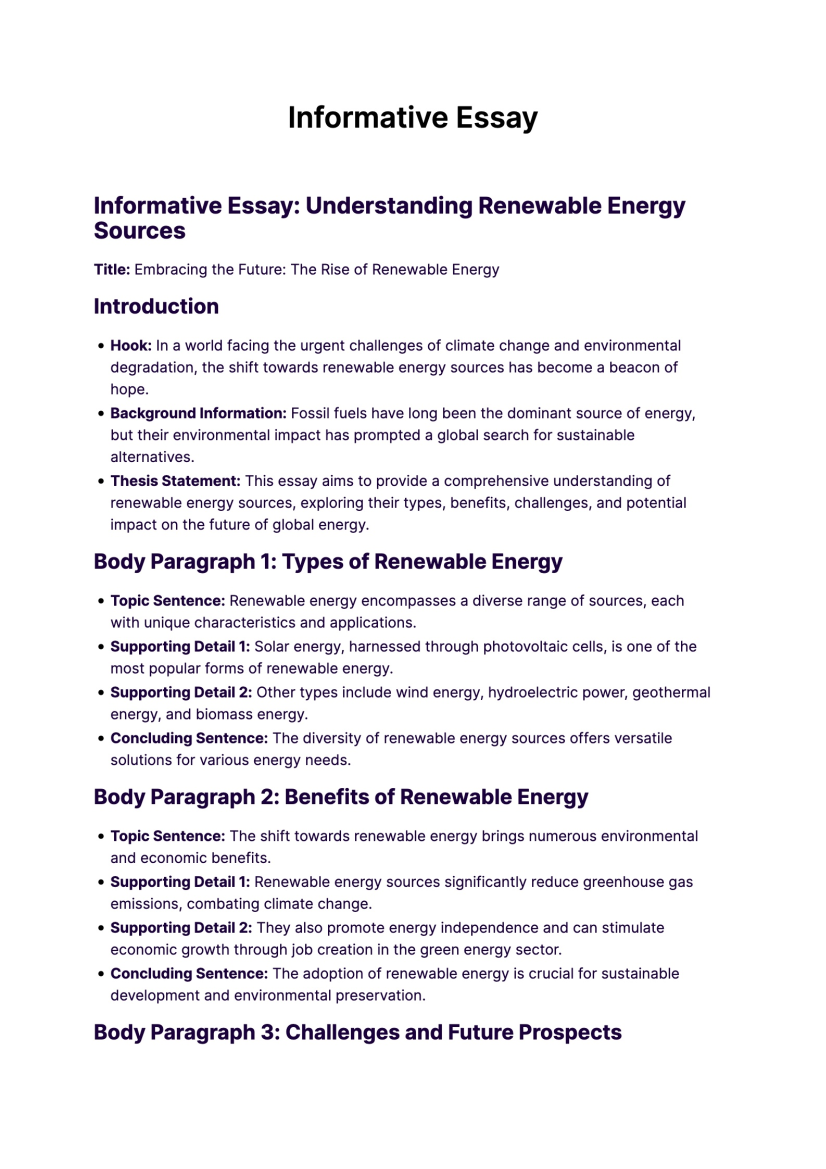
Free Download
Informative Essay Outline

School Informative Essay

Informative Essay Example

Expository Informative Example

Student Informative Sample
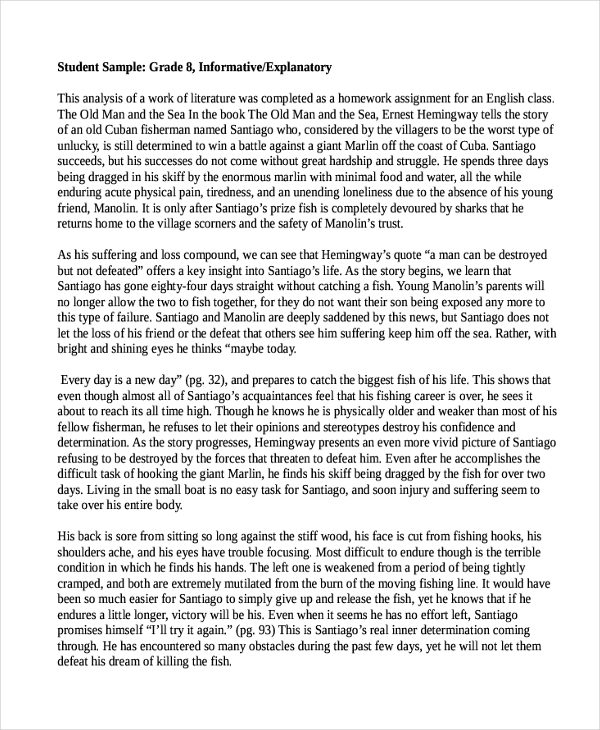
Short Informative Essay

What Is an Informative Essay?
Informative essay is a written as literary essay piece with the purpose of educating a target audience or readers regarding a certain topic or subject.
It is intended to present or expose something while at the same time avoiding to present arguments or personal opinion from the writer. An informative essay is also sometimes called an expository essay in the sense that it also aims to expose or display an information which will be beneficial for the reader.
It does not present bias judgments nor favorable ideas. It does not also dwell in the concept of convincing readers to do things that are contrary to their will.
How to Write an Informative Essay
Writing an informative essay is like telling a blind person what is the color of the sky or telling a kid what are ice creams made of. You simply just have to present a topic and expand.
- Think of a topic. The first thing that you have to do is think of a topic that you want to right about. It would be good if it is something that you are most passionate about so you can write in great details.
- Create a format. The most effective format is using the essential parts of an essay .
- Present your ideas. After choosing the topic, start writing your ideas. Try to present it in a way that you are educating the readers.
College Informative Essay
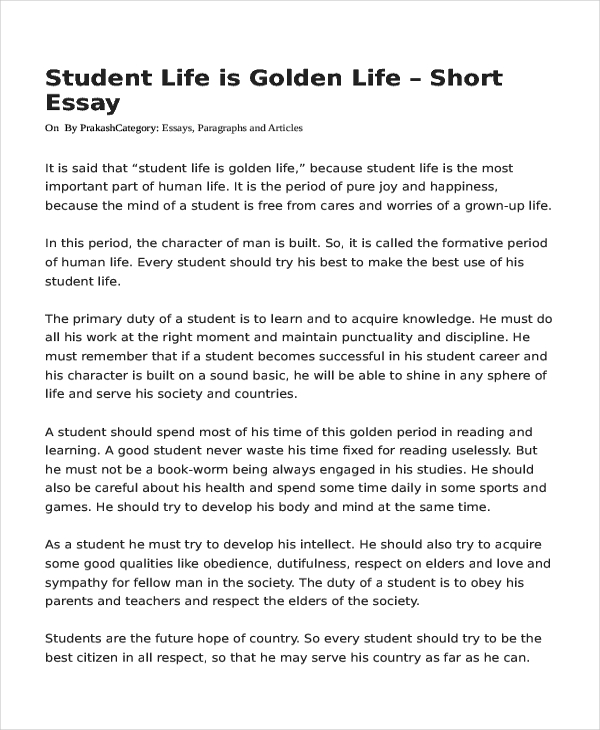
Middle School Informative

Narrative Informative Example
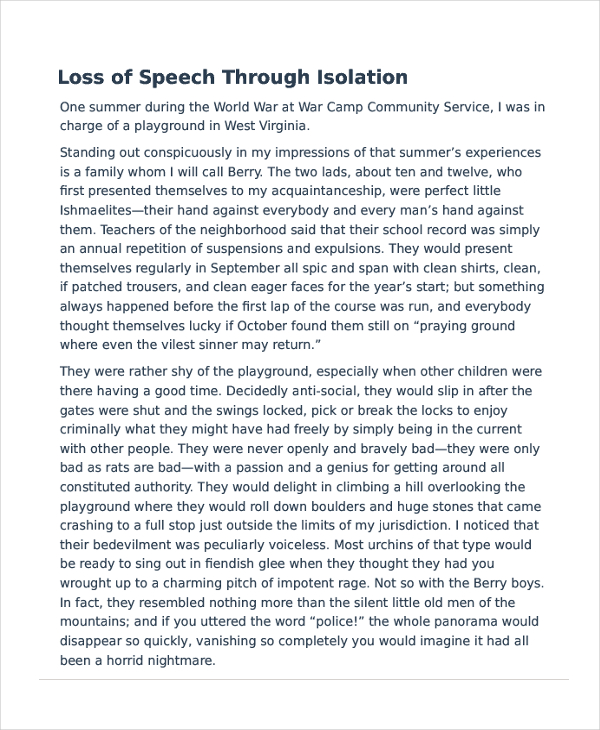
Informative Essay Example
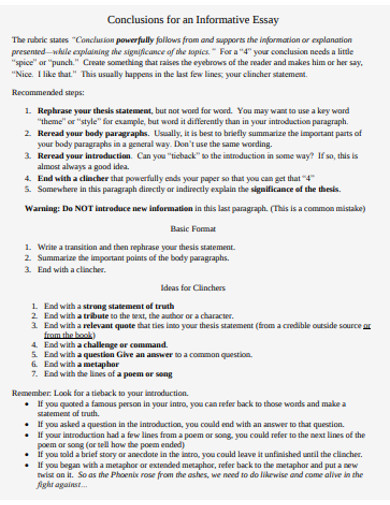
Sample Informative Essay
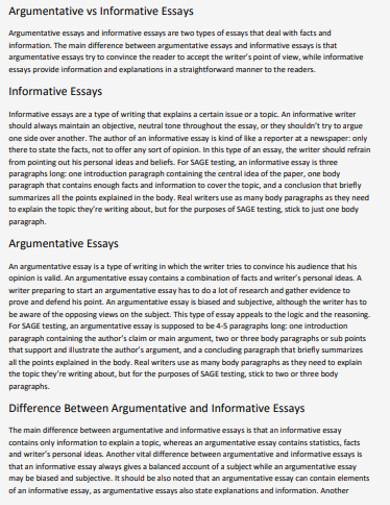
Informative Organizer Essay
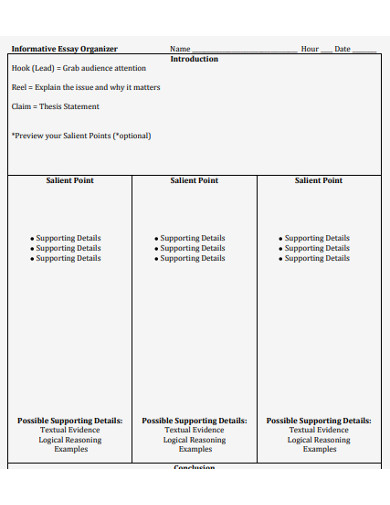
Informative Assignment Essay
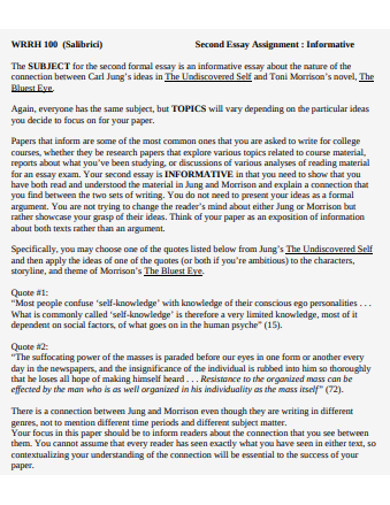
Uses of Informative Essay
1. educational tools.
- Learning and Teaching : Informative essays are widely used in educational settings to teach students about specific topics. They serve as a means for students to research, organize, and present information, enhancing their learning process. For educators, these essays are a tool to assess students’ understanding and ability to communicate knowledge effectively.
2. Enhancing Understanding
- Complex Concept Clarification : These essays break down complex concepts into more understandable parts, making it easier for readers to grasp difficult subjects. They can demystify scientific principles, historical events, or technological advancements, providing clarity and insight.
3. Communication of Ideas
- Knowledge Sharing : In professional and academic communities, informative essays facilitate the sharing of knowledge and ideas. They allow experts to communicate findings, theories, and analyses, contributing to the collective understanding of a field.
4. Awareness and Information Dissemination
- Public Awareness : Informative essays play a crucial role in raising awareness about important issues, such as health, environmental concerns, and social justice. By presenting facts and information, they help inform public opinion and encourage informed decision-making.
5. Basis for Further Research
- Foundation for Exploration : These essays provide a foundation for further research. By offering a comprehensive overview of a topic, they can inspire readers to explore subjects in greater depth, paving the way for advanced studies and discoveries.
6. Professional Development
- Skill Enhancement : Writing informative essays helps individuals develop valuable skills, including research, critical thinking, organization, and writing. These skills are essential in many professional contexts, enhancing career prospects and professional competence.
7. Decision Making and Problem Solving
- Informed Decisions : In the business world and personal life, informative essays can provide the necessary background to make informed decisions. Understanding all aspects of a situation or topic can lead to better problem-solving strategies and outcomes.
8. Cultural and Social Engagement
- Cultural Insight : Essays about cultural practices, societal trends, and historical backgrounds offer readers insights into different ways of life and perspectives, promoting cultural understanding and empathy.
9. Personal Growth
- Intellectual Stimulation : Reading and writing informative essays can be intellectually stimulating, encouraging curiosity and a love for learning. They can broaden one’s horizons and foster a more informed and thoughtful perspective on the world.
Importance of Informative Essay
- Facilitates Learning and Education : They are essential tools in educational settings, helping students learn and understand various topics across different subjects.
- Promotes Critical Thinking : Writing and reading informative essays encourage critical thinking by requiring analysis and synthesis of information.
- Enhances Research Skills : The process of writing an informative essay improves research skills, teaching individuals how to gather, evaluate, and organize information effectively.
- Improves Writing and Communication Skills : Informative essays help in honing writing skills, including structuring arguments, maintaining clarity, and engaging the audience with informative content.
- Encourages Intellectual Curiosity : They stimulate curiosity about the world, encouraging readers and writers to explore topics deeply and broadly.
- Supports Informed Decision Making : By presenting facts and data, informative essays enable readers to make decisions based on knowledge and insights rather than assumptions or misinformation.
- Builds a Foundation for Further Study : They lay the groundwork for more in-depth research and analysis, serving as a stepping stone to more specialized studies.
- Spreads Awareness on Important Issues : Informative essays are a powerful medium for raising awareness about social, environmental, and health-related issues, contributing to public education and action.
- Promotes Cultural Understanding and Empathy : Essays on cultural and societal topics promote understanding and empathy towards different communities and ways of life.
- Contributes to Professional Development : The skills gained from researching and writing informative essays are valuable in professional settings, enhancing abilities in documentation, presentation, and critical analysis.
- Serves as a Source of Inspiration : Reading informative essays can inspire new ideas, hobbies, or even career paths by introducing readers to previously unknown subjects or deeper aspects of familiar topics.
- Facilitates Clear and Effective Information Dissemination : In both academic and professional contexts, the ability to clearly and effectively disseminate information is critical, and informative essays are an excellent medium for this purpose.
How Do You Start an Informative Essay Sentence?
Start an informative essay sentence with a hook such as a surprising fact, a question, or a quote to grab the reader’s attention and draw them into the topic.
How Do You Structure an Informative Essay?
Structure an informative essay with an introduction that includes a hook and thesis statement, body paragraphs that explore the topic in detail, and a conclusion that summarizes the main points.
What Should Each Body Paragraph Begin With?
Each body paragraph should begin with a topic sentence that introduces the main idea of the paragraph, directly supporting the thesis statement.
What Are the Informative Writing Techniques?
Informative writing techniques include using clear and concise language, organizing information logically, employing facts and data for support, and incorporating visuals like charts or graphs to enhance understanding.
How Do You Start an Informative Letter?
Start an informative letter with a polite greeting, followed by a clear introduction of the purpose of the letter. Provide the necessary information in a concise and organized manner.
What Are the Parts of an Informative Essay?
The parts of an informative essay include the introduction with a hook and thesis statement, body paragraphs with topic sentences and supporting details, and a conclusion that summarizes the essay’s main points.
The basic parts or elements of an essay are the introduction, the body, and the conclusion. These are all important parts which of course constitutes the wholeness of your essay.
So each part has to be given with special importance. The conclusion of essay , which is the last part, should be your chance to make your readers understand the whole point of your topic.
This is the chance for you to clarify some important things that you want to highlight. It is advisable that you write at least three to five sentences for your conclusion in order for it not to become too explanatory which you have already done on the previous part.
Text prompt
- Instructive
- Professional
Crafting the Perfect Thesis for Your Informative Essay
How to Research Effectively for an Informative Essay
Structuring Your Informative Essay: A Step-by-Step Guide
Selecting the Best Topic for Your Informative Essay
The Importance of Editing Your Informative Essay
Incorporating Visuals into Your Informative Essay
Tips for Writing an Engaging Informative Essay Introduction
Developing Strong Arguments in Your Informative Essay
Informative Essay Conclusion: Leaving a Lasting Impression
Avoiding Plagiarism in Your Informative Essay

IMAGES
VIDEO